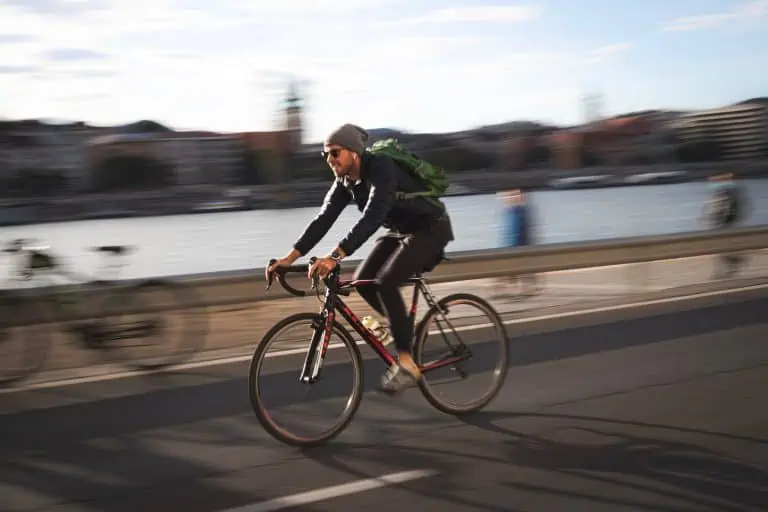Tackling Common Causes of Knee Pain While Cycling

Identifying Common Causes and Solutions for Knee Pain While Cycling
As a cyclist, understanding the signals your knees send when they’re in distress is crucial. These signals often manifest as aches and pains, and if you experience them, you’re not alone. Knee pain affects between 15 to 33 percent of cyclists, according to a 2018 review in the Open Access Journal of Sports Medicine.
Fortunately, the causes are often straightforward to address. The first step is to identify what’s causing your knee pain. For example, overtraining and pushing your body too hard can strain your connective tissues, leading to inflammation and pain.
Cycling Knee Pain Symptoms and Remedies
Pain in the Front of the Knee
Pain in the front of the knee, typically around the patella, often involves the quadriceps muscles. These muscles attach to the shin via the patella, and the force they exert during pedaling can stress the knee joint.
Solution: Adjust your bike setup. Check your saddle height, fore-aft saddle position, and crank length. A professional bike fitting can be incredibly helpful.
- Saddle Height: If too low, it increases shear forces on the patella. To check, sit on your bike with your heel on the pedal at the 6 o’clock position; your knee should be straight.
- Saddle Position: Ensure your saddle is not too far forward. The tibial tuberosity (the bony bit below the kneecap) should align with the pedal spindle.
Avoid big-gear mashing, climbing in high gears, and hard sprinting if you’re not conditioned for it. Stretching your quads can also provide relief.
Read more: Best Bikes for Back Pain
Pain in the Back of the Knee
Pain behind the knee is usually due to over-extension, often from a saddle that’s too high or too far back.
Solution: Lower the saddle or move it forward slightly. If you ride a fixed-gear bike, take breaks to avoid overworking your hamstrings. Stretching your hamstrings can also help.
Pain on the Inside of the Knee
Inner knee pain is often related to improper cleat placement, affecting your Q-factor (the lateral spacing of your feet when pedaling).
Solution: Adjust your cleats so the loads travel vertically through your knees, reducing stress on the collateral ligaments. A little pedal float (about 4.5 degrees) can prevent knee stress. If pain persists, consider stretching your hip flexors and adductors.
Pain on the Outside of the Knee
Outer knee pain is often due to iliotibial (IT) band syndrome, caused by misaligned cleats or too narrow a stance.
Solution: Adjust your cleat position or consult a professional fitter. Ensuring your cleats are not too far outside your shoes can help. Stretching and strengthening the IT band can also be beneficial.
How to Prevent Cycling Knee Pain
Warm-Up
A proper warm-up is essential for preparing your muscles and joints for the demands of cycling. Start by spending at least 15 minutes spinning at a moderate pace. This gentle activity increases blood flow to your muscles, raising their temperature and making them more pliable.
A good warm-up reduces the risk of injury and can enhance your performance by preparing your cardiovascular system and improving muscle efficiency. Incorporate some dynamic stretches, focusing on your legs and lower back, to further prime your body for the ride ahead. Gradually increase your intensity towards the end of the warm-up to ease into your main cycling session.
Focus on Pedal Stroke
Focusing on your pedal stroke is crucial for efficiency and knee health. Emulate professional cyclists by maintaining a rapid, fluid pedaling motion. This smooth technique reduces stress on your joints and maximizes power transfer. Practice using a gear that is two teeth lower than usual when climbing.
This adjustment forces you to pedal at a higher cadence, which is easier on your joints and helps develop a more efficient pedal stroke. Visualize making round circles with your feet rather than ovals to ensure even power distribution throughout the entire pedal cycle. Regularly incorporating these drills can significantly improve your cycling performance and comfort.
Build Mileage Gradually
Avoid the temptation to jump into long rides immediately after a break. Sudden increases in mileage can overstrain your muscles and joints, leading to knee pain and other injuries. Start with shorter, manageable distances and gradually increase your mileage by no more than 10% per week.
This gradual build-up allows your body to adapt to the increased demands, improving your endurance and strength over time. Pay attention to how your body responds to each ride and adjust your training plan accordingly. Incorporate rest days and lower-intensity rides to facilitate recovery and prevent overtraining.
Beware of Change
Introducing new equipment, such as a bike, shoes, or pedals, should be done gradually. Your knees need time to adjust to these changes, as sudden alterations can lead to improper alignment and increased stress on your joints.
When you get new equipment, start with shorter rides and gradually increase the duration and intensity as your body adapts. Pay close attention to any signs of discomfort or pain, and make necessary adjustments to your setup. Consider seeking the advice of a professional bike fitter to ensure that your new equipment is properly aligned with your body’s biomechanics.
Stay Warm
Keeping your knees warm in cooler weather is vital for preventing stiffness and injury. Professional cyclists often cover their legs when the temperature drops below 60 degrees Fahrenheit. Consider using knee warmers or thermal cycling tights to maintain warmth in your joints and muscles.
Cold weather can reduce blood flow and increase the risk of injuries, so staying warm helps keep your muscles flexible and responsive. Layer your clothing appropriately, and remove layers as you warm up during the ride. Paying attention to your body’s signals and adjusting your gear accordingly can help you stay comfortable and injury-free in varying weather conditions.
Get a Bike Fit
If you experience persistent knee pain, investing in a professional bike fit can be transformative. A comprehensive bike fitting session goes beyond basic adjustments; it includes an interview to understand your cycling habits, off-bike flexibility tests, and precise on-bike measurements and adjustments. A professional fitter will consider your body’s unique biomechanics and ensure that your bike setup is optimized for comfort and efficiency.
This personalized approach can address underlying issues that contribute to knee pain, such as improper saddle height, incorrect cleat position, or handlebar reach. Though it may be an investment, a professional bike fit can significantly enhance your riding experience and prevent long-term injuries.
Read more: How Much Does a Bike Fit Cost
Fix Muscle Imbalances
Muscle imbalances, such as weak glutes, hips, or core muscles, can contribute to persistent knee pain. Addressing these imbalances is crucial for long-term relief and improved performance. Consult with a sports medicine physician or physical therapist who can assess your muscle strength and flexibility. They can prescribe targeted exercises to strengthen weak areas and improve overall muscle coordination.
Incorporating strength training and stretching routines into your regular training can help balance your muscle groups, enhance stability, and reduce the risk of knee pain. Consistent attention to muscle balance will not only alleviate pain but also boost your cycling efficiency and endurance.
By addressing these common causes and implementing these preventive strategies, you can enjoy cycling without knee pain.






